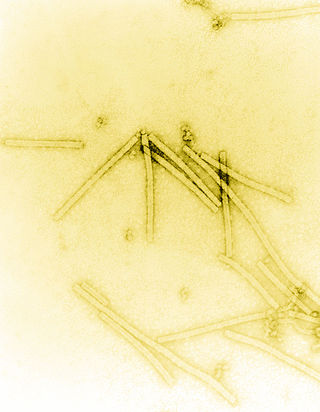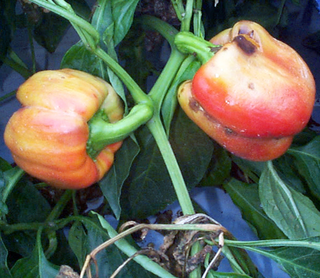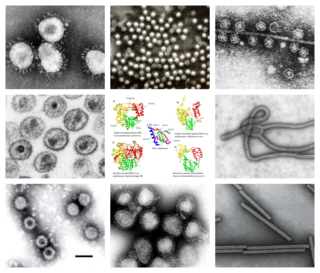
Tobacco mosaic virus (TMV) is a positive-sense single-stranded RNA virus species in the genus Tobamovirus that infects a wide range of plants, especially tobacco and other members of the family Solanaceae. The infection causes characteristic patterns, such as "mosaic"-like mottling and discoloration on the leaves. TMV was the first virus to be discovered. Although it was known from the late 19th century that a non-bacterial infectious disease was damaging tobacco crops, it was not until 1930 that the infectious agent was determined to be a virus. It is the first pathogen identified as a virus. The virus was crystallised by W.M. Stanley. It has a similar size to the largest synthetic molecule, known as PG5.

Tombusviridae is a family of single-stranded positive sense RNA plant viruses. There are three subfamilies, 17 genera, and 95 species in this family. The name is derived from Tomato bushy stunt virus (TBSV).

Brome mosaic virus (BMV) is a small, positive-stranded, icosahedral RNA plant virus belonging to the genus Bromovirus, family Bromoviridae, in the Alphavirus-like superfamily.

Tobamovirus is a genus of positive-strand RNA viruses in the family Virgaviridae. Many plants, including tobacco, potato, tomato, and squash, serve as natural hosts. Diseases associated with this genus include: necrotic lesions on leaves. The name Tobamovirus comes from the host and symptoms of the first virus discovered.

Cowpea mosaic virus (CPMV) is a non-enveloped plant virus of the comovirus group. Infection of a susceptible cowpea leaf causes a "mosaic" pattern in the leaf, and results in high virus yields. Its genome consists of 2 molecules of positive-sense RNA which are separately encapsidated. Both RNA1 and RNA2 have a VPg at the 5'end, and polyadenylation at the 3' end. Genomic RNA1 and RNA2 are expressed by a polyprotein processing strategy. RNA1 encodes helicase, VPg, protease and RdRp. RNA2 encodes movement protein and coat protein. The virus particles are 28 nm in diameter and contain 60 copies each of a Large (L) and Small (S) coat protein. The structure is well characterised to atomic resolution, and the viral particles are thermostable. The identification of the virus is attributed to Lister and Thresh in 1955, but it is now known as a variant of the Sunn-hemp mosaic virus.

Alfalfa mosaic virus (AMV), also known as Lucerne mosaic virus or Potato calico virus, is a worldwide distributed phytopathogen that can lead to necrosis and yellow mosaics on a large variety of plant species, including commercially important crops. It is the only Alfamovirus of the family Bromoviridae. In 1931 Weimer J.L. was the first to report AMV in alfalfa. Transmission of the virus occurs mainly by some aphids, by seeds or by pollen to the seed.
Arabis mosaic virus is a viral plant pathogen that is known to infect multiple hosts. The pathogen, commonly referred to as ArMV, is from the family Secoviridae, and it causes yellow dwarf of raspberry and is one of the causes of mosaic of rhubarb. Arabis mosaic virus infects multiple hosts, including strawberries, hops, hemp, grape, geraniums, raspberries, sugar beets, celery, horseradish, lilac, peach, and lettuces.

Apple mosaic virus (ApMV) is a plant pathogenic virus of the family Bromoviridae. It is named after its symptoms that were first present on apples. ApMV is a positive sense RNA based virus. The disease itself has several synonyms including Mild Apple Mosaic Virus, Hop Virus, Rose Mosaic Virus, and European Plum Line Patten Virus. It causes a severe yield reduction and decreased life-expectancy of fruit trees.

Cucumber mosaic virus (CMV) is a plant pathogenic virus in the family Bromoviridae. This virus has a worldwide distribution and a very wide host range, having the reputation of the widest host range of any known plant virus. It can be transmitted from plant to plant both mechanically by sap and by aphids in a stylet-borne fashion. It can also be transmitted in seeds and by the parasitic weeds, Cuscuta sp. (dodder).

Cymbidium mosaic virus (CymMV) is a plant pathogenic virus of the family Alphaflexiviridae.

Pepper mild mottle virus (PMMoV) is a plant pathogenic virus that occurs worldwide on species of field grown bell, hot and ornamental pepper species. It is caused by members of the plant virus genus Tobamovirus- otherwise known as the tobacco mosaic virus family. Tobamovirus are viruses that contain positive sense RNA genomes that infect plants. Symptoms of the disease vary depending on the cultivar. Typical symptoms include the chlorosis of leaves, stunting, and distorted and lumpy fruiting structures. The virus is spread by mechanical transmission and infected seeds. Avoidance is the best means of controlling the disease because once a plant is infected it cannot be treated. Only seeds that have been tested and treated for the pathogen should be planted.

Wheat streak mosaic virus (WSMV) is a plant pathogenic virus of the family Potyviridae that infects plants in the family Poaceae, especially wheat ; it is globally distributed and vectored by the wheat curl mite, particularly in regions where wheat is widely grown. First described in Nebraska in 1922, stunted growth and the eponymous “streaks” of yellowed, non-uniform discoloration are characteristic of WSMV infection. As it has been known to cause 100% crop mortality, WSMV is a subject of ongoing scientific research.

Orthotospovirus is a genus of negative-strand RNA viruses, in the family Tospoviridae of the order Bunyavirales, which infects plants. Tospoviruses take their name from the species Tomato spotted wilt orthotospovirus (TSWV) which was discovered in Australia in 1919. TSWV remained the only known member of the family until the early 1990s when genetic characterisation of plant viruses became more common. There are now at least twenty species in the genus with more being discovered on a regular basis. Member viruses infect over eight hundred plant species from 82 different families.

Watermelon mosaic virus (WMV) also known as Marrow mosaic virus, Melon mosaic virus, and until recently Watermelon mosaic virus type 2 (WMV-2), is a plant pathogenic virus that causes viral infection in many different plants. The virus itself is referred to as Watermelon Mosaic Virus II or WMV-2 and is an isolate of the U.S. WMV-2 is a ssRNA positive strand virus that is part of the Potyviridae or Potyvirus clade. Like all RNA viruses, it contains a protein capsid which protects the inner viral RNA. First described on squash in Florida, WMV arose from a unique recombination of genetic material contributed by Soybean mosaic virus (SMV) and Bean common mosaic virus (BCMV) along with Peanut Stripe virus (PSV).
Tungrovirus is a genus of viruses, in the family Caulimoviridae, order Ortervirales. Monocots and family Poaceae serve as natural hosts. There is only one species in this genus: Rice tungro bacilliform virus. Diseases associated with this genus include: stunting, yellow to orange leaf discoloration with fewer tillers. Tungro means 'degenerated growth' in a Filipino dialect and the virus was first observed in the Philippines 1975.

Riboviria is a realm of viruses that includes all viruses that use a homologous RNA-dependent polymerase for replication. It includes RNA viruses that encode an RNA-dependent RNA polymerase, as well as reverse-transcribing viruses that encode an RNA-dependent DNA polymerase. RNA-dependent RNA polymerase (RdRp), also called RNA replicase, produces RNA from RNA. RNA-dependent DNA polymerase (RdDp), also called reverse transcriptase (RT), produces DNA from RNA. These enzymes are essential for replicating the viral genome and transcribing viral genes into messenger RNA (mRNA) for translation of viral proteins.
The cardamom mosaic virus (CdMV) is a mosaic virus that affects the production of green cardamom. It is a member of the genus Macluravirus, and is transmitted through aphids and infected rhizomes, the former in a non-persistent manner.

The Blueberry mosaic associated ophiovirus (B1MaV) is a plant virus which infects blueberry plants, causing a discoloration of the leaves of the plants in a mosaic-like pattern. The disease is found in blueberry plants in many regions of North America, as well as South America, Europe, New Zealand, and South Africa. Within these regions the virus is most often found in high blueberry-yielding areas, but can be spread to other locations. Blueberry mosaic associatedophiovirus is one of seven species in the genus Ophiovirus. It is a member of the Aspiviridae family, in the Serpentovirales order, and in the Milnevircetes class. The Ophioviridae viruses are characterized by a flexible and elongated nucleocapsid that is composed mostly of filamentous structures and is helically symmetrical. It also has a non-enveloped protein capsid that is capable of coiling around itself allowing for a super-coiled structure and the helical symmetry. The virus has the potential to be symptomatic or asymptomatic within plants causing the display of symptoms in only a few plants, but the ability to transmit the virus unknowingly in many plants. B1MaV often remains asymptomatic for long periods of time after initial infection allowing for blind transmission.

Tomato brown rugose fruit virus (ToBRFV) is a plant virus in the genus Tobamovirus that was first described in 2015. It has spread rapidly since it was first noted in Jordan and Israel. The main hosts are tomato and peppers. The virus causes symptoms including mosaic and distortion of leaves and brown, wrinkly spots (rugose) on fruits. Outbreaks can be severe and leave fruit unmarketable.

Orthornavirae is a kingdom of viruses that have genomes made of ribonucleic acid (RNA), those genomes encoding an RNA-dependent RNA polymerase (RdRp). The RdRp is used to transcribe the viral RNA genome into messenger RNA (mRNA) and to replicate the genome. Viruses in this kingdom also share a number of characteristics involving evolution, including high rates of genetic mutations, recombinations, and reassortments.
















